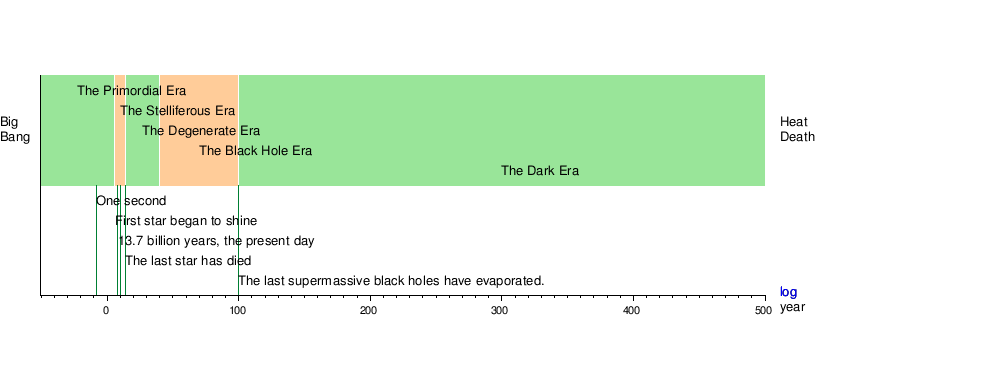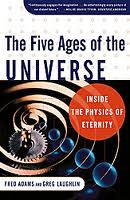Unless otherwise noted,
the material on this page may be used under the terms of a
Creative Commons License.
| Cosmological Time | ||
| Time | Five ages of the Universe |
| Time | Primordial Cosmos | Geological Time | ||
| The Discovery of Deep Time |
Cosmology | Similar: Logarithmic Timescale | Primordial Cosmos | Geological Timescale |
Timescale Main Page |
Cosmological Time |

The following is copied almost verbatim from Wikipedia. While I find speculation into extremely remote future ages dubious, because of any number of possible variables (discovery of a new cosmological force leading to a big crunch or oscillating universe, brane theory alternative to inflation, hyper-advanced trans-singularity intelligences practicing space-time engineering, etc etc), it makes for an interesting example of a logarithmic timescale. The names of the two "briefest" ages, the Primordial and the Stelliferous, have been adopted in the cosmological review in Palaeos. MAK110725

The Five Ages Of The Universe is a popular science book written by Professor Fred Adams and Gregory Laughlin first published in 1999. It discusses the history, present state, and probable future of the universe, according to cosmologists' current understanding. The book divides the timeline of the universe into five eras: the Primordial Era, the Stelliferous Era, the Degenerate Era, the Black Hole Era and the Dark Era.
In addition to explaining current cosmological theory, the authors speculate on what kinds of life might exist in future eras of the universe. The speculation is based on a scaling hypothesis, due to Freeman Dyson, the idea being that all other things being equal the rate of metabolism -- and therefore rate of consciousness -- of an organism should be in direct proportion to the temperature at which that organism thrives. The authors envision life forms completely different from the biochemical ones of Earth, for example based on networked black holes.
Primordial Era: The Primordial Era is defined as "-50 <n; n <n; 5". In this era, the Big Bang, the subsequent inflation, and Big Bang nucleosynthesis are thought to have taken place. Toward the end of this age, the recombination of electrons with nuclei made the universe transparent for the first time. The authors discuss the horizon and flatness problems.
Stelliferous Era: The Stelliferous Era is defined as "6 <n; n <n; 14". This is the current era, in which matter is arranged in the form of stars, galaxies, and galaxy clusters, and most energy is produced in stars. Massive stars use up their fuel very rapidly, in as little as a few million years. Eventually, the only stars will be miserly red dwarf stars. By the end of this era, bright stars as we know them will be gone, their nuclear fuel exhausted, and only white dwarfs, brown dwarfs, and black holes will remain. In this section, Olbers' paradox is discussed.
Degenerate Era: The Degenerate Era is defined as "15 <n; n <n; 39".This is the era of brown dwarfs, white dwarfs, and black holes. White dwarfs will assimilate dark matter and continue with a nominal energy output. As this era continues, the authors hypothesize that protons will begin to decay (violating the conservation of baryon number given by the Standard Model). If proton decay takes place, the sole survivors will be black holes.
Black Hole Era: The Black Hole Era is defined as "40 <n; n <n; 100". In this era, according to the book, organized matter will remain only in the form of black holes. Black holes themselves slowly "evaporate" away the matter contained in them, by the quantum mechanical process of Hawking radiation. By the end of this era, only extremely low-energy photons, electrons, positrons, and neutrinos will remain.
Dark Era: The Dark Era is defined as "n >n; 101". By this era, with only very diffuse matter remaining, activity in the universe will have tailed off dramatically, with very low energy levels and very large time scales. Electrons and positrons drifting through space will encounter one another and occasionally form positronium atoms. These structures are unstable, however, and their constituent particles must eventually annihilate. Other low-level annihilation events will also take place, albeit very slowly.
It should be emphasised that the above represents one possible time line, and one possible perspective on things, and is not a dogmatic statement. There are also the linear, ascending alternative. However, this sort of ascending evolution is only possible in the Stelliferous Era, where the universe is differentiated and transparent to radiation, and there is an abundance of free energy. Evolution towards greater complexity is an obvious fact from both a cosmological and systems theory perspective; as pointed out by writers such as Erich Jantsch, Irwin Laszlo, and Eric Chaisson. But it is also very much a product of, or rather, as I prefer critical realism to the epistemological prison of neo-kantean agnosticism, an insight of, 19th and 20th century optimism. It doesn't necessarily follow that the human race will continue the push towards greater complexity, although it may; several speculative options are presented here. Ascent to greater complexity is also very much disliked by some evolutionary biologists (S.J. Gould, also some cladists) because they want to avoid mentioning any hint of progress in the evolution life. Personally I consider such a position extreme, although others may disagree with me. In any case, Palaeos' review of the history of life on Earth through deep time follows a course perpendicular to the "five ages" logarithmic timescale. MAK110729.
| Primordial Cosmos | Geological Time |
content by MAK110729, Wikipedia. Edited RFVS111026